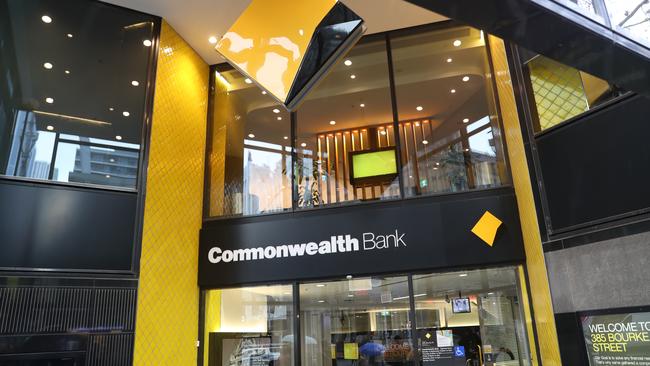CBA has a massive market share. It manages one in four home mortgages. The bank’s share of household deposits is even higher at 27.5 per cent. In business lending, it’s got 16 per cent and catching up with arch rival NAB.
What we have here is a bellwether stock – one from which we can draw a wider picture of the entire market.
And the good news is that CBA offered not just a strong result but an up-tempo outlook for the months ahead.
CEO Matt Comyn believes the Australian economy is heading for a soft landing. He thinks rates will not go as high as most in the market believe.
Comyn, of course, is only guessing. But if you run a bank with a return on equity coming close to 13 per cent and you just pulled in a profit increase of 11 per cent to $9.5bn, your outlook matters more than most.
(Just to put the scale of that profit in perspective, it’s more than double the entire market capitalisation of AMP).

If Comyn has it right then the official rate will go to 2.6 per cent from 1.85 per cent now – but not as high as 3 per cent, which is closer to consensus estimates.
For now he continues to offer the party line that house prices will fall 15 per cent, peak to trough – though this is obviously open to revision. Better still, this outlook assumes inflation will start to fall sooner than most expect as well.
Put simply, that means the entire economy rebounds faster than most expect.
Many private investors still see the big four banks as very much interchangeable with broadly similar metrics. Not so. CBA is in a league of its own; the rest are trotting behind … miles behind.
Over the past 12 months, CBA revenues and profits were higher. Growth did slow in the second half but costs fell too.
Provisioning – setting aside money for tougher times – was higher than the market expected. Clearly the hot issue for the bank is the outlook for the housing market and how mortgage holders will deal with the rapid increase in mortgage rates.
The flashpoint is the 40 per cent of borrowers who took out fixed-rate loans at the peak of the housing cycle. This group is due to ‘‘come off’’ these exceptionally low 3 per cent mortgages and face new rates close to 5 per cent.
Bank analysts worry this ‘‘mortgage cliff’’ will cause defaults across the market. Specifically, they assume CBA could lose market share to competitors.
The concerns are entirely justifiable, but not the inability to foresee that the nation’s biggest bank could undercut the rest of the market with the flick of a switch. This bank has three quarters of its funding coming from deposits – it’s a King Kong. It could unleash a price war and it might barely register on the bottom line.
Analysts also point to declining interest margins at the bank, which is a real concern. However, all banks are yet to get the kicker from rising rates, where margin expansion is due to come though in the months ahead.
As we see clear evidence that inflation is peaking in the US, global and local sharemarkets have been rebounding in recent weeks.
It is against this backdrop we might consider Comyn’s outlook at the results presentation, when he said: “It is a challenging time but we remain optimistic that a path can be found to navigate through these economic conditions. We remain of the view that the medium-term outlook for Australia is a positive one.”
The essential point for stock investors is that Comyn is aggressive and optimistic in his outlook, while being conservative in his actual day-to-day running of the bank in tandem with CFO Alan Docherty.
CBA has actually been provisioning – or putting money aside for tougher times – at a rate that is higher than required by the regulators.
And if you thought that the former Commonwealth Savings Bank still struggles with millions of low-income customers while the mass affluent like to bank elsewhere, that’s all changed.

Dig deeper and you’ll find it’s the main bank for about one third of all Australians, but the market share rises with younger customers. It also has a grip on the middle class, with around half of all investment loans going out to customers with income of more than $200,000.
This does not mean the bank won’t make mistakes or take wrong turns, but it is in very good shape on all the key numbers.
On that basis you might think the market is backing CBA all the way, but the stock is utterly out of favour with professional investors.
The fully franked total dividend of $3.85 – which was better than expected – might be favoured by everyday investors but it is of little consequence to analysts who have one eye on overseas institutional investors.
Ask a broker for a recommendation on the bank stocks just now and they would be lukewarm on the sector and least enthusiastic about CBA.
With the bank trading at around $100 – and unchanged by the results presentation – the average price target is $87. There is even that rarest of calls – a ‘‘sell’’ – on CBA.
Macquarie snipes at its mainstream rival, suggesting the “traditional premium awarded to CBA shares is seen as too bloated, trading at its highest historical price-earnings multiple and compared with 25 global banks”.
Meanwhile, Morgans has a price target of just $77 on the stock.
Russel Chesler, head of investments at VanEck, captures the caution in the market.
“CBA continues to trade at a premium to other big banks and is arguably overvalued,” he said. “As the nation’s biggest home lender, it is most exposed to the property slowdown. We do not believe that the trading premium is sustainable in the long term and at some point CBA will be rerated.”
Fund managers and brokers seem to be assuming CBA stock will decline in the months ahead because it can’t keep producing results like we have just seen. Because it will sink with the wider housing market. Because some other bank will come along and knock it off its perch. But the numbers speak for themselves.








The annual results from the Commonwealth Bank mark something of a watershed each year for investors. It’s not just the best of the bank stocks, it’s a unique window into the Australian economy.